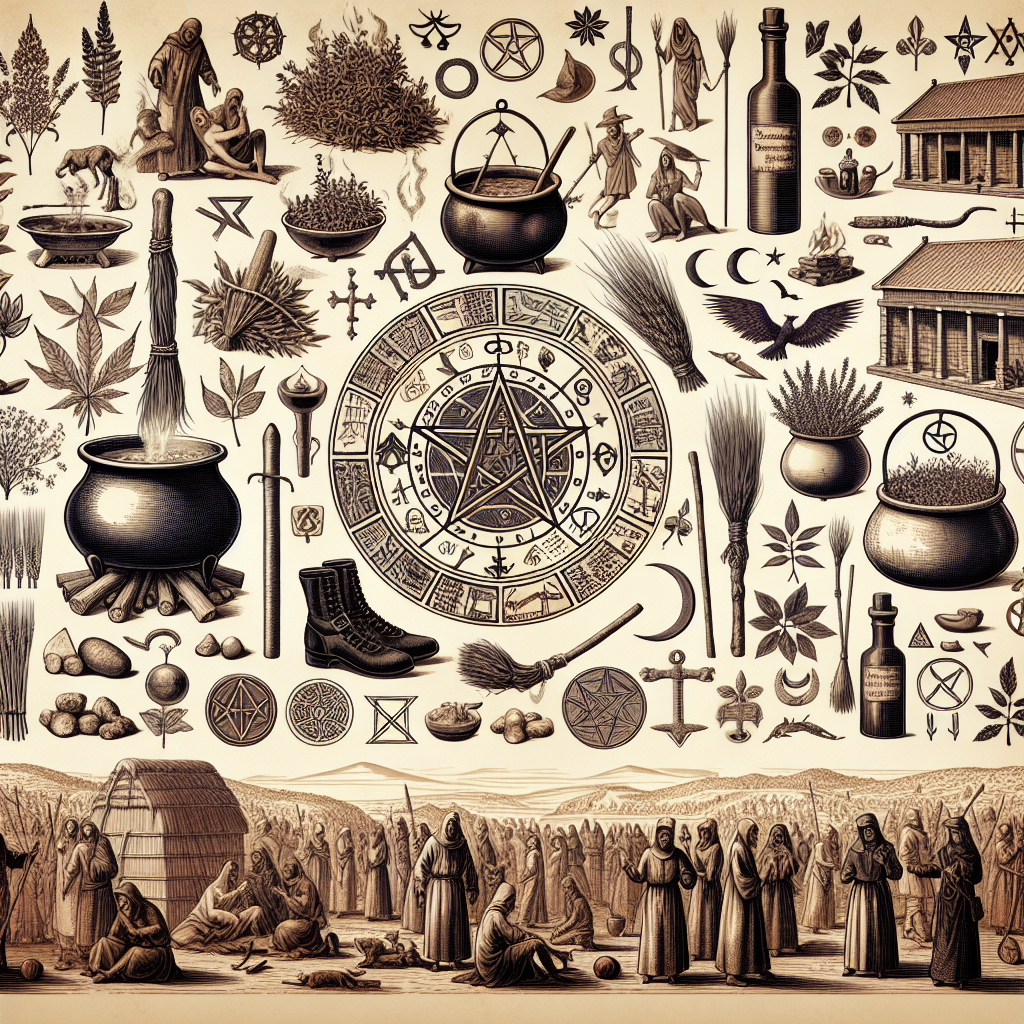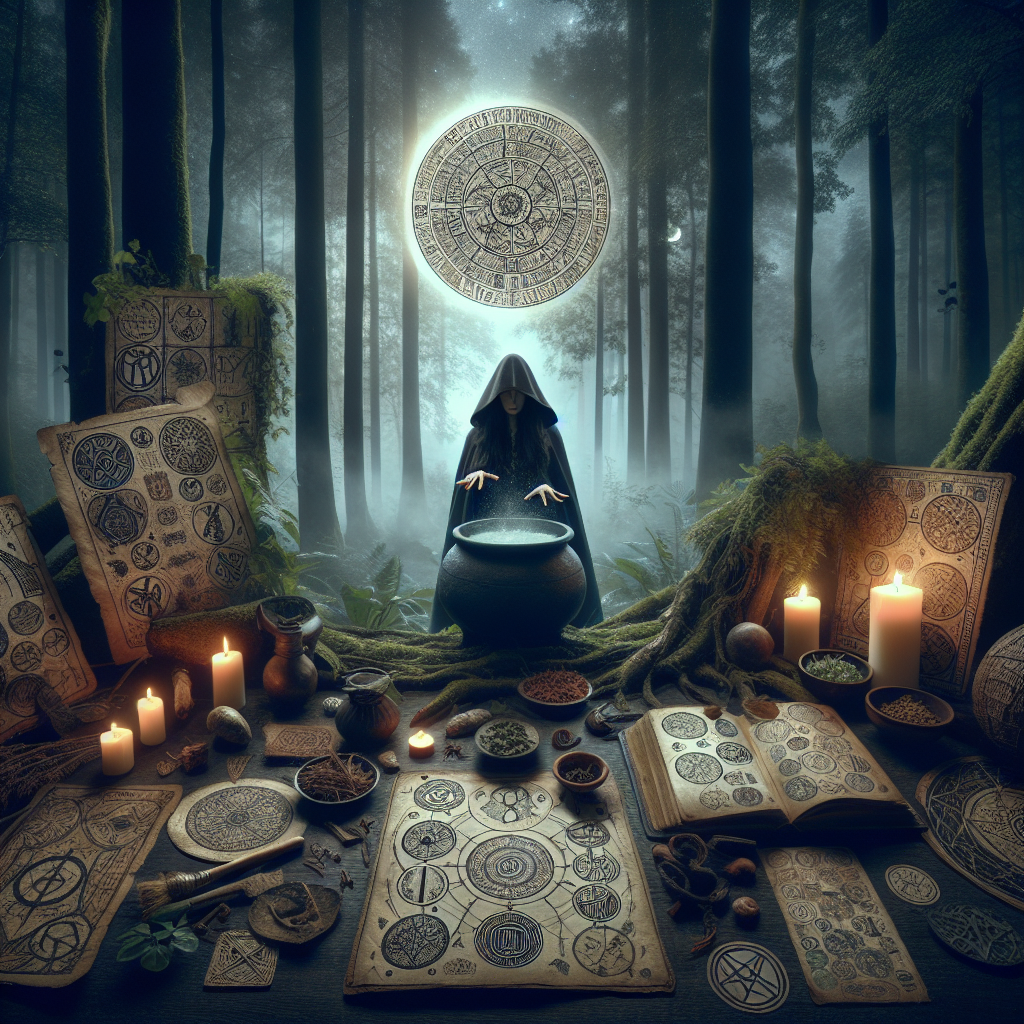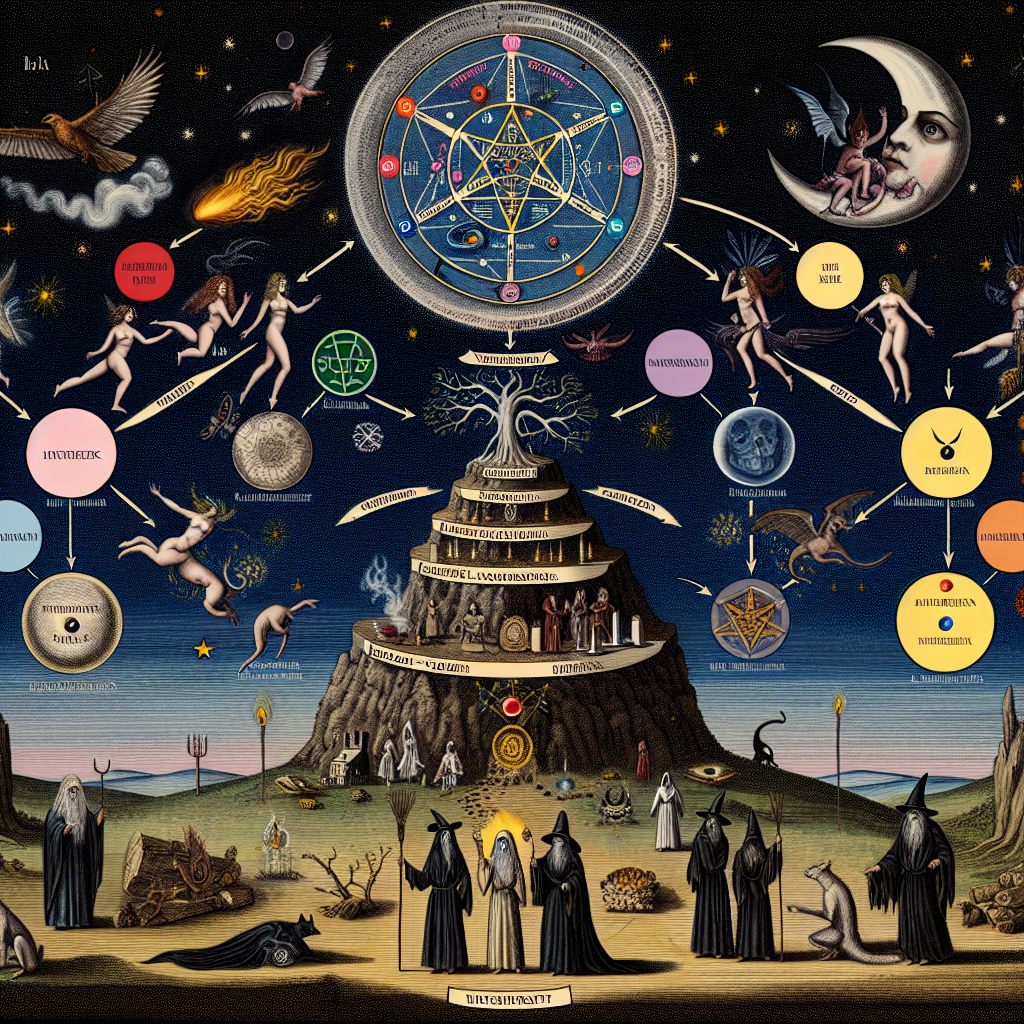As an Amazon Associate I earn from qualifying purchases.

Witchcraft, in various forms, has been recorded as far back as written history goes, with ancient texts such as the Bible referencing practices that could be construed as witchcraft. This enduring association with the mystical and the unexplained reveals humanity’s desire to understand and influence the natural and supernatural worlds.
Tracing the origins of witchcraft leads us into the shadowy prehistory of humanity, where the earliest spiritual practices merged with what we might now describe as witchcraft. Ancient peoples around the world held beliefs in powerful spirits, deities, and a connectedness among all living things. Shamanism, for instance, is a practice that predates recorded history, where shamans would enter trance states to interact with the spirit world for healing or guidance. Similarly, ancient Sumerian and Egyptian civilizations had their own magico-religious practitioners, some of whom could arguably be termed as ‘witches’ in a broad sense of the term.
During the Middle Ages in Europe, witchcraft began to be associated with heresy and devil-worship. This resulted in the persecution of individuals, predominantly women, who were accused of practicing malicious magical arts. A compelling statistic from this period is the estimate that tens of thousands of supposed witches were executed during the witch trials that swept across Europe between the 15th and 18th centuries, a testament to the fear and misunderstanding that surrounded the practice.
In the modern world, perceptions of witchcraft have dramatically transformed. Witchcraft today encompasses a variety of belief systems and practices, including Wicca, which emerged in the mid-20th century and is recognized as an official religion in several countries. Contemporary witchcraft generally emphasizes reverence for nature, the practice of magic, and the worship of a goddess and sometimes a god. The Pew Research Center’s data reveals that as of the 2010s, approximately 0.4% of Americans identify as Wiccan or Pagan, reflecting growing acceptance of these previously marginalized practices.
While pop culture often depicts witchcraft in a sensational light, it is—like any belief system—complex and multi-faceted, with a rich history that continues to evolve. Today’s witches may practice alone or in groups known as covens, and their rituals can range from simple acts imbued with personal significance to highly structured ceremonies. These modern iterations of witchcraft are often deeply personal, with practitioners adapting historical traditions to suit their individual beliefs and lifestyles.
“`html
Tracing the Origins of Witchcraft: A Deep Dive into Its Historical Roots
“`
Witchcraft, often associated with ancient rituals, pagan beliefs, and supernatural practices, has a rich and complex history that transcends geographical and cultural boundaries. Its roots can be traced back to prehistoric times, when early humans engaged in shamanistic activities to communicate with the spiritual world. Throughout the ages, witchcraft evolved, absorbing influences from various religious and folkloric traditions. It served as both a means to explain the unexplainable and a mechanism to harness perceived powers for healing, harm, or social control. This intricate tapestry of beliefs and practices has been shaped by societal transformations, religious conflicts, and cultural exchanges. As we delve deeper into the historical exploration of witchcraft, we’ll uncover the multifaceted layers of its development and the pivotal moments that have defined its journey through the ages.
The roots of witchcraft stretch deep into the annals of human history, intertwining with the spiritual practices and beliefs of ancient civilizations. Witchcraft, as a term, generally refers to the practice of magical skills, spells, and abilities that is done either for the purpose of self-governance, spiritual or medicinal healing, or as a form of religious devotion. Tracing where witchcraft came from involves a journey through time and across continents, from prehistoric shamanistic rituals to the complex religious tapestries of the ancient world.
Prehistoric Shamanism and Sorcery
In the earliest human cultures, shamanism was widely practiced. Shamans were seen as intermediaries between the human and spirit worlds, with the ability to heal the sick, foretell the future, and control spiritual forces. These abilities can be seen as a precursor to what would later be termed witchcraft. Cave paintings, such as those found in the Lascaux Caves in France, which date back to around 17,000 BCE, provide some of the earliest evidence of shamanistic rituals, indicating that concepts foundational to witchcraft have existed for millennia.
Ancient Mesopotamian Witchcraft
The earliest written records of practices resembling witchcraft come from ancient Mesopotamia, especially from the Sumerian civilization around 4,000 BCE. This region had a profound belief in the supernatural, and its inhabitants performed rituals to appease gods, spirits, and demons. The Sumerian text, “Maqlû,” also known as the “Burning of the Sorceress,” is a spell series from around 900 BCE and describes rituals that counteract witchcraft, demonstrating both a belief in such practices and an attempt to control them.
Egyptian Magical Practices
Ancient Egyptians also engaged in practices that could be identified with witchcraft. They used spells, curses, and amulets for protection, health, and personal advantage. The “Book of the Dead,” a collection of funerary texts from New Kingdom Egypt (c. 1550–1070 BCE), contains many spells designed to aid the deceased in the afterlife, manifesting the intertwining relationship between magic and religion.
Classical Antiquity: Greece and Rome
In ancient Greece and Rome, magic was a complex and nuanced phenomenon, with literary and archaeological sources referencing curse tablets, amulets, and love spells. Figures like Circe and Medea from Greek mythology have been depicted as enchantresses with magical powers, and their stories have shaped the concept of witchcraft in Western imagination. During the Roman Empire, laws against magical practices were enacted, showing the authorities’ attempt to regulate or eliminate witchcraft.
The European Witch Craze
The notion of witchcraft took on a more malignant form in Europe during the medieval period gradually evolving towards the early modern period. The “witch craze” of the 15th to the 17th century saw thousands of people, mostly women, accused of witchcraft, often resulting in execution. Texts such as the “Malleus Maleficarum” (The Hammer of Witches) of 1487 codified the beliefs about witchcraft at the time and provided guidelines for the prosecution of witches.
Indigenous Traditions across the Globe
Looking globally, many indigenous cultures have their forms of what could be classified as witchcraft, though they may not use that term. These practices, rooted deeply in the local spiritual beliefs and natural world, often involve healing, divination, and protection rituals. They have been passed down through generations and are a testament to the diverse expressions and understandings of magical practices.
Modern Revival of Witchcraft
In more recent times, the 20th century saw a revival of interest in witchcraft, tied to larger religious movements such as Wicca, which was introduced by Gerald Gardner in the 1950s. This modern form of witchcraft combines pre-Christian spiritual practices with ceremonial magic and folklore.
Witchcraft Today
Today, witchcraft is practiced in various forms worldwide, ranging from traditional indigenous rituals to modern pagan and neopagan faiths. It has become increasingly mainstream and popular, with practitioners approaching it from a spiritual, religious, or secular viewpoint, all while focusing on personal empowerment, environmental awareness, and self-improvement.
The historical exploration of witchcraft shows its ubiquitous nature throughout human history and across cultures. Despite attempts to eradicate it, witchcraft has persisted and transformed over centuries. According to the Pew Research Center in a study conducted in 2014, approximately 0.4% of Americans, or around 1 to 1.5 million people, identified as Wiccan or Pagan, underscoring the enduring and evolving presence of witchcraft in modern society.
1. What are the origins of witchcraft?
Witchcraft is believed to have ancient origins, dating back to the prehistoric times when humanity’s spiritual and superstitious beliefs were intertwined with their everyday lives. It likely developed from these early practices of shamanism and paganism before recorded history.
2. How did different cultures influence the development of witchcraft?
Different cultures have had a significant impact on the evolution of witchcraft. From the shamanistic practices in Siberia and Asia to the ancient Egyptian magical rituals, and from the Greco-Roman traditions to the Celtic druidism, various cultural beliefs and practices have all contributed to the tapestry of what is known as witchcraft today.
3. Was witchcraft always considered evil?
No, witchcraft was not always considered evil. In many societies, it was a part of their spiritual or healing practices. However, with the advent of major organized religions and especially during the Middle Ages in Europe, witchcraft began to be associated with heresy and devil-worship, leading to its demonization.
4. How did Christianity impact the perception of witchcraft?
Christianity played a significant role in changing the perception of witchcraft. As the Church sought to consolidate its power, it often labeled pre-Christian spiritual practices as heretical or devilish, leading to widespread fear and persecution of those believed to be practicing witchcraft.
5. What was the Witch Craze, and when did it occur?
The Witch Craze, often referred to as the Witch Hunts, was a period of mass hysteria and persecution that took place mainly in Europe between the 15th and 18th centuries. It was characterized by the widespread belief that witchcraft was real and had to be rooted out of society, often leading to trials and executions.
6. How did the Witch Trials affect the practice of witchcraft?
The Witch Trials had a profound impact on the practice of witchcraft. Many people who practiced folk magic or herbalism, often for benevolent purposes, were forced to do so in secrecy for fear of persecution. The trials also led to the loss of much knowledge about traditional practices due to the execution of those accused.
7. Are there any regions in the world where witchcraft was never persecuted?
There are regions and indigenous cultures where witchcraft, in the form of traditional spiritual practices, was not persecuted to the same extent as in Europe and North America, particularly in areas less affected by colonialism and Christian missionary work, such as certain parts of Asia, Africa, and the Americas.
8. How has modern witchcraft evolved from ancient practices?
Modern witchcraft has evolved significantly from ancient practices. It often integrates elements of ancient paganism, occultism, and folk tradition, but it is also influenced by modern values and inclusive spirituality. Contemporary witchcraft, such as Wicca, places a strong emphasis on personal experience and ecological awareness.
9. Can witchcraft still be found in modern times?
Yes, witchcraft is still practiced today in various forms around the world. It has seen a resurgence in popularity as part of the New Age movement and is embraced by those seeking alternative spirituality, such as Wicca, eclectic witchcraft, and other neopagan paths.
10. How does contemporary society view witchcraft?
Contemporary society’s views on witchcraft are mixed. While there are still some stigmas and misconceptions due to historical prejudices, there is also a growing acceptance and interest in witchcraft as a legitimate spiritual path. Witchcraft is increasingly recognized for its cultural significance and its role in folklore, mythology, and anthropology.

Conclusion
The historical exploration of witchcraft reveals its roots as a complex tapestry, interwoven with the cultural, religious, and societal threads of human history. From the shamanistic practices of prehistoric societies to the Greco-Roman spells and incantations, witchcraft has been a multifaceted phenomenon. As it evolved, it absorbed elements from folklore, pagan beliefs, and healing traditions—yielding a rich variety of practices that were often vilified by the rise of Christianity. The Church’s attempts to eradicate what it perceived as heresy led to the conflation of local customs with devil worship, culminating in the infamous witch hunts and trials that left an indelible mark on the collective psyche.
This exploration underlines the fact that witchcraft, historically, has been a symbol of the Other, representing a resistance to established power structures and serving as a scapegoat for societal ills. The varying interpretations and reactions to witchcraft across different eras and regions—from medieval Europe’s persecutions to the African and Native American spiritual systems’ demonization by colonizers—highlight the dynamic interplay between power, fear, and the unknown. Understanding the origins of witchcraft not only demystifies the stereotypes associated with it but also sheds light on the broader patterns of cultural assimilation, oppression, and the human tendency to vilify what is not understood, reflecting an ongoing narrative that continues to influence contemporary views on alternative spiritualities and lifestyles.
Amazon and the Amazon logo are trademarks of Amazon.com, Inc, or its affiliates.


